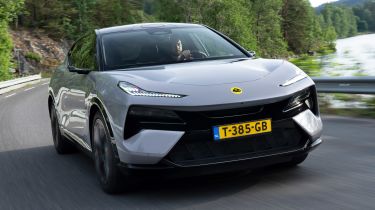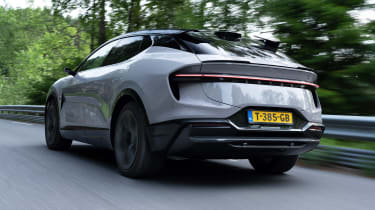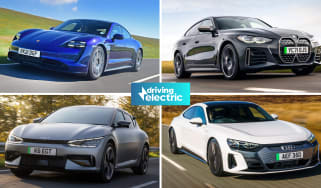Lotus Eletre review
The Lotus Eletre is nothing like we’ve ever seen before from the British brand, but is a triumphant success regardless

Pros
- Blistering acceleration
- Sharp handling
- Modern and luxurious interior
Cons
- Overly sharp throttle
- High price and running costs
- Unknown reliability
| Car type | Range | Wallbox charge time | Rapid charge time |
|---|---|---|---|
| Electric | 373 miles | 17hrs est. (0-100%, 7.4kW) |
20mins (10-80%, 350kW) |
Lotus Eletre verdict
At face value, the Lotus Eletre really seems to be the chalk to the Emira sports car’s cheese. However, despite being powered by electricity and weighing almost twice as much as its two-seater sibling, there are more similarities between the two than you might expect. Both feel surprisingly well-made for low-volume British performance cars, while direct steering and a well-balanced chassis mean either will leave you with a silly grin on your face after a run down the right road. The biggest weapon in the Eletre’s arsenal, however, is the sheer amount of performance on offer; the electric Lotus SUV offers supercar-levels of acceleration in something you can take to do the weekly shop. The British marque has always been about managing weight and while the Eletre is undeniably heavy, it succeeded in disguising the SUV’s bulk, while also setting a new benchmark for driver enjoyment in electric SUVs.
Details, specs and alternatives
Lotus is a brand that’s close to the hearts of many British petrolheads, but one that few have ever fully experienced due to the impractical nature of its cars. With many questioning how it’ll survive in the electrified age of motoring, the maker surprised us with its plug-in hypercar, the Evija, and now – to the shock of many – has introduced an all-electric SUV called the Lotus Eletre.
Sure there are many electric SUVs that offer blistering levels of performance – we’re looking at you, Tesla Model X Plaid – but the Eletre is designed to be fun as well as fast, targeting buyers of the Porsche Taycan Cross Turismo and BMW iX M60.
All versions of the Lotus Eletre get an enormous 112kWh lithium ion battery which, while it can provide a range of up to 373 miles, does mean the brand with the motto “simplify, then add lightness” now sells an SUV with a kerb weight that starts “from 2,520kg”. Ouch.
We’ll get onto whether that affects the driving experience later. For now, we’ll focus on how the Eletre is available in three different specifications: the eponymous Eletre, the Eletre S and the range-topping Eletre R. All feature dual-motor powertrains offering four-wheel-drive, with the base Eletre and Eletre S both outputting a not-insignificant 595bhp. The 0-62mph sprint takes just four-and-a-half seconds which, if you think that’s quick, wait till you hear about the Eletre R.
With a staggering 893bhp and 985Nm of torque being sent to all four wheels, the Eletre R will spring from 0-62mph in just 2.9 seconds – only a whisker behind the aforementioned Model X Plaid, and faster than a petrol-powered Lamborghini Urus Performante. Range in the Eletre R is reduced to 304 miles, though.
The Eletre is rather expensive, but standard-fit air suspension, the choice of a four or five-seat layout, quad-zone climate control, a 360-degree camera system and an expansive 15-inch touchscreen should mean no buyer will feel short-changed – a good thing, given prices start from around £90,000.
Range, battery size & charging
| Model | Range | Wallbox charge time | Rapid charge time |
|---|---|---|---|
| Eletre/Eletre S | 373 miles | 17hrs est. (0-100%, 7.4kW) |
20mins (10-80%, 350kW) |
| Eletre R | 304 | 17hrs est. (0-100%, 7.4kW) | 20mins (10-80%, 350kW) |
The Lotus Eletre’s 112kWh battery is one of the largest we’ve seen fitted to a production electric car. This, Lotus says, will provide a range of up to 373 miles on both the Eletre and Eletre S models – likely to be the biggest sellers in the UK. This is on-par with the BMW iX XDrive50 and significantly more than what you’ll get in a Mercedes-AMG EQE 53 SUV. The range-topping Eletre R will need plugging-in after 304 miles, according to Lotus’s numbers.

Our time in the Eletre S revealed that you should easily get close to Lotus’ claimed figures, which came as a pleasant surprise. After two days of, shall we say, ‘spirited’ driving, we still had well over 20% charge left after covering around 240 miles.
All Lotus Eletre models – again, according to Lotus – can charge at speeds of up to 350kW, making it the fastest-charging electric car you can currently buy. Despite its massive battery, find one of the few 350kW ultra-rapid chargers in the UK and Lotus says you can top-up the Eletre from 10-80% in just 20 minutes. A more-common 100kW charger will complete the same charge in just under an hour, while making use of a standard 7.4kW home wallbox will fully charge the Eletre in around 17 hours.
Running costs & insurance
While most electric vehicles can be incredibly cheap to run, the Lotus Eletre is a bit of a mixed bag as not only does it cost a lot to buy, but its large battery means it’ll set you back quite a bit to charge up – even at home. A full charge at the current average electricity rate (30p per kWh) will cost over £30, while using a public rapid charger could cost upwards of £70 – almost as much as filling up a combustion-engined SUV with petrol.
Don’t go considering whether you need to sell a kidney just yet; business owners or high-ranking employees able to claim the Eletre as a company car will be pleased to know the electric Lotus slots into the lowest 2% Benefit-in-Kind tax bracket. Owners in the 40% tax bracket could pay as little as £716 per year in company car tax, while the Eletre, like all EVs, is also exempt from road tax (VED) until 2025. It can enter London Congestion Charge and Ultra-Low Emissions (ULEZ) zones for free, too.
Performance, motor & drive
We think it’s best with the Lotus Eletre to manage your expectations: if you don’t go in expecting it to match the same raw engagement offered by the brand’s celebrated historic lineup of classic sports cars, then you’ll be suitably impressed by the dynamics of the two-and-a-half tonne SUV. The steering is incredibly sharp, making the Eletre feel more than agile enough to tackle a challenging B-road, while there’s plenty of feel in the brakes and the standard-fit air suspension does well to iron out most of the imperfections in the tarmac.
Even the entry-level Eletre and Eletre S with their 595bhp powertrains feel incredibly brisk; of course, there’s that instant shove you get from the acceleration – a hallmark of electric cars – but with a 0-62mph time of just 4.5 seconds, we feel there’s not much need to step up to the frankly bonkers range-topping Eletre R. This version feels mind-bogglingly fast and can be a little too lively at times – especially given how sensitive the throttle is.
Interior, dashboard & infotainment
‘Bare bones’ is a good way to describe Lotus interiors of old; drivers would previously have thought themselves lucky with little more than a radio and a heater. However, as we keep reiterating, the Eletre is a very different kind of Lotus and this is perhaps most apparent when you step inside; the Eletre’s cabin is frankly exquisite, with luxurious leather and sustainable fabrics, plus beautifully milled aluminium inserts. While we can’t say for sure whether there’ll be some squeaks or other unwanted wear over time, what we can say for now is that the Eletre’s cabin feels even more special than a Porsche Taycan’s.
The Eletre should manage to impress tech fans with its sweeping 15-inch central touchscreen. This comes as standard with built-in sat nav, but buyers can also make use of the Apple CarPlay and Android Auto connectivity. The display itself is bright, crisp and just as responsive as the latest smartphones. It’s also supplemented by two slim instrument displays – one for the driver and another for the front passenger. These show all the things you’d expect like your current speed and media playback, with the second screen attempting to make the front passenger feel just as part of the action as the driver.
Boot space, seating & practicality
The Lotus Eletre is available with either four or five seats; we suspect the majority of cars will go out with a traditional bench seat in the back, although opting for the four-seater layout nets you a swanky first class-style centre console between the rear seats featuring another touchscreen that mirrors the one in the front.
There’s plenty of head and legroom in either configuration, with the Eletre’s 688-litre boot shrinking slightly to 611 litres for the four seat model. Even so, this should be more than enough to swallow a couple of full-size suitcases, although the Eletre doesn’t have any additional storage in the form of a ‘frunk’ under the bonnet.
Reliability & safety rating
Aside from perhaps Alfa Romeo, Lotus is the last name you’d probably think of when talking about reliability. However, the Eletre is separated from its forebears in this regard as it sits on parent brand Geely’s Electric Premium Architecture (EPA) platform, which is also set to underpin the upcoming Polestar 3. Only time will tell whether it will prove reliable, but it's worth pointing out that EVs should, in theory, be more dependable than the equivalent petrol car due to having fewer moving parts to go wrong.
The Lotus Eletre should be very safe, though. It’s equipped with a variety of safety features, including a built-in LIDAR sensor which can detect faraway objects and makes the Eletre capable of Level 4 autonomous driving, where the law allows. Even when you’re driving the car yourself, the Eletre boasts things like lane-keep assist, autonomous emergency braking and blind-spot monitoring to help prevent accidents.










